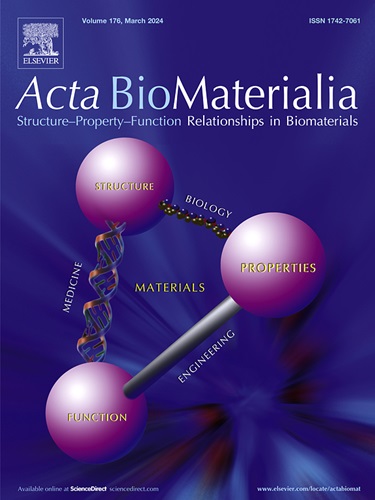Developing and characterising bovine decellularized extracellular matrix hydrogels to biofabricate female reproductive tissues
IF 9.4
1区 医学
Q1 ENGINEERING, BIOMEDICAL
引用次数: 0
Abstract
This study investigated the development and characterization of decellularized extracellular matrix (dECM) hydrogels tailored for the biofabrication of female reproductive tissues, specifically targeting ovarian cortex, endometrium, ovarian medulla, and oviduct tissues. We aimed to evaluate the cytocompatibility, biomechanical properties, and overall efficacy of these dECMs in promoting cell viability, proliferation, and morphology using the bovine model. Bovine species provide a valuable model due to their accessibility from slaughterhouse tissues, offering a practical alternative to human samples, which are often limited in availability. Additionally, bovine tissue closely mirrors certain physiological and biological characteristics of humans, making it a relevant model for translational research. Our findings revealed that these dECMs exhibited high biocompatibility with embryo development and cell viability, supporting micro vascularization and cellular morphology without the need for external growth factors. It is important to note that the addition of alginate was crucial for maintaining the structural integrity of the hydrogel during long-term cultures. These hydrogels displayed biomechanical properties that closely mimicked native tissues, which was vital for maintaining their functional integrity and supporting cellular activities. The printability assessments showed that dECMs, particularly those from cortex tissues, achieved high precision in replicating the intended structures, though challenges such as low porosity remained. The bioprinted constructs demonstrated robust cell growth, with over 97% viability observed by day 7, indicating their suitability for cell culture. This work represented a significant advancement in reproductive tissue biofabrication, demonstrating the potential of dECM-based hydrogels in creating structurally and viable tissue constructs. By tailoring each dECM to match the unique biomechanical properties of different tissues, we paved the way for more effective and reliable applications in reproductive medicine and tissue engineering.
Statement of Significance
This research explores the use of decellularized extracellular matrix (dECM) hydrogels as bio-inks for creating reproductive tissues. Ovarian cortex and medulla, oviduct and endometrium dECMs demonstrated biomechanical properties that mimicked native tissues, which is essential for maintaining functional integrity and supporting cellular processes. Notably, these hydrogels exhibited high biocompatibility with embryo development and cell viability, promoting microvascularization and cell differentiation without the need for supplemental growth factors. The successful bioprinting of these bio-inks underscores their potential for creating more complex models. This work represents a significant advancement in tissue engineering, offering promising new avenues for reproductive medicine.

开发和表征牛脱细胞细胞外基质水凝胶生物制造女性生殖组织。
本研究研究了用于女性生殖组织生物构建的脱细胞细胞外基质(dECM)水凝胶的开发和特性,特别是针对卵巢皮质、子宫内膜、卵巢髓质和输卵管组织。我们的目的是利用牛模型评估这些decm的细胞相容性、生物力学特性和促进细胞活力、增殖和形态的总体功效。牛物种提供了一个有价值的模型,因为它们可以从屠宰场的组织中获得,为人类样本提供了一个实用的替代方案,而人类样本的可用性往往有限。此外,牛组织密切反映了人类的某些生理和生物学特征,使其成为转化研究的相关模型。我们的研究结果表明,这些decm在胚胎发育和细胞活力方面表现出高度的生物相容性,支持微血管形成和细胞形态,而不需要外部生长因子。值得注意的是,在长期培养过程中,海藻酸盐的添加对于保持水凝胶的结构完整性至关重要。这些水凝胶表现出与天然组织相似的生物力学特性,这对于维持其功能完整性和支持细胞活动至关重要。可打印性评估表明,尽管存在低孔隙率等挑战,但decm,特别是来自皮质组织的decm,在复制预期结构方面取得了很高的精度。生物打印的构建物显示出强劲的细胞生长,在第7天观察到超过97%的存活率,表明它们适合细胞培养。这项工作代表了生殖组织生物制造的重大进步,证明了基于decm的水凝胶在创建结构和可行的组织构建方面的潜力。通过定制每个dECM以匹配不同组织的独特生物力学特性,我们为在生殖医学和组织工程中更有效和可靠的应用铺平了道路。意义声明:本研究探索了使用脱细胞细胞外基质(dECM)水凝胶作为生物墨水来创建生殖组织。卵巢皮层和髓质、输卵管和子宫内膜decm表现出模仿天然组织的生物力学特性,这对于维持功能完整性和支持细胞过程至关重要。值得注意的是,这些水凝胶在胚胎发育和细胞活力方面表现出高度的生物相容性,促进微血管形成和细胞分化,而无需补充生长因子。这些生物墨水的成功生物打印强调了它们创造更复杂模型的潜力。这项工作代表了组织工程学的重大进步,为生殖医学提供了有希望的新途径。
本文章由计算机程序翻译,如有差异,请以英文原文为准。
求助全文
约1分钟内获得全文
求助全文
来源期刊

Acta Biomaterialia
工程技术-材料科学:生物材料
CiteScore
16.80
自引率
3.10%
发文量
776
审稿时长
30 days
期刊介绍:
Acta Biomaterialia is a monthly peer-reviewed scientific journal published by Elsevier. The journal was established in January 2005. The editor-in-chief is W.R. Wagner (University of Pittsburgh). The journal covers research in biomaterials science, including the interrelationship of biomaterial structure and function from macroscale to nanoscale. Topical coverage includes biomedical and biocompatible materials.
 求助内容:
求助内容: 应助结果提醒方式:
应助结果提醒方式:


